Surface Roots: Unsightly and Unsafe!
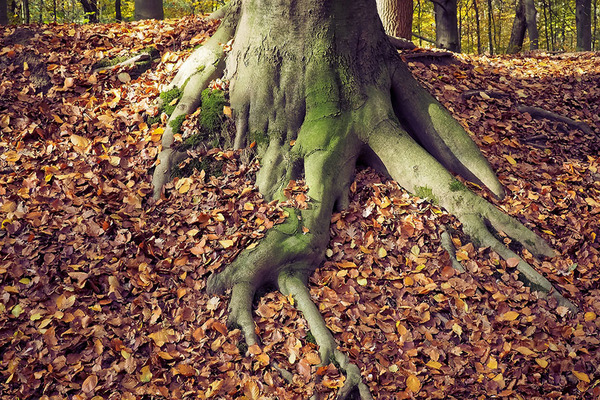
Photo by Michael Gaida on Pixabay
Managing Surface Roots: A Comprehensive Guide to Safety and Aesthetics
Unsightly and potentially hazardous, surface roots in yards with large trees can be a major concern for homeowners. These roots not only hamper lawn maintenance but also have the potential to crack sidewalks, creating both visual and safety issues.
More than mere eyesores, they present a tangible danger underfoot. In this comprehensive guide, we delve into the causes of surface roots, exploring the intricate balance between tree health and property aesthetics.
Our aim is to provide practical suggestions on how to manage these roots effectively, ensuring both safety and a visually appealing landscape.
Understanding the Causes
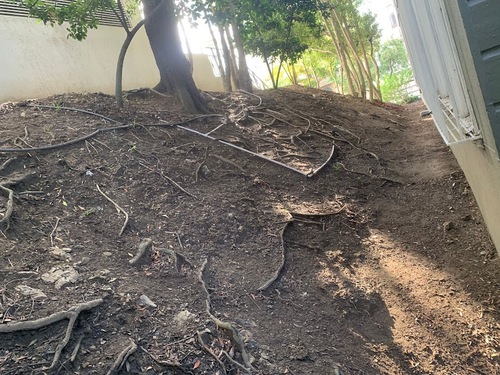
Surface Roots are Visible Throughout this Sloped Landscaping
Shallow Roots of Popular Landscaping Trees
Many popular landscaping trees tend to develop surface roots due to their inherently shallow root systems. While it's a natural growth pattern for large trees, other factors contribute to the problem. We'll go into more depth on these problematic tree varieties in a following section.
Impact of Soil Quality
Poor soil quality plays a crucial role in the development of surface roots. Tree roots of most trees are found in the top twelve inches of soil. These roots rarely grow very deep unless the tree is planted in loose and sandy soil. Compacted or clay-based soils greatly contribute to surface rooting, especially in urban areas where these types of soils are found. Erosion caused by rain and wind exposes the roots, making them more visible and prone to damage.
Oxygen Deficiency
Roots require oxygen for the tree's survival. In compacted soil, roots grow toward the surface to access sufficient oxygen. Trees with surface roots are often struggling to breathe and adapt to an environment that may not be ideal for their health.
Why They're Problematic
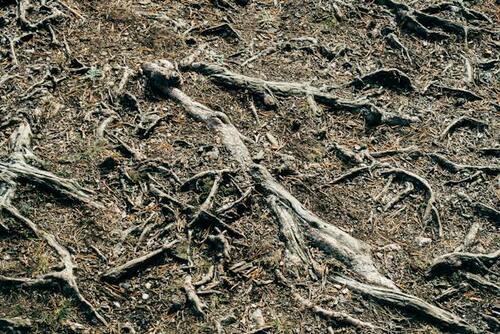
Exposed, Worn Tree Roots - Photo by Markus Winkler on Pixabay
There are a number of reasons why surface roots are a significant concern for anyone with trees. Here are the heavy hitters:
Damage to Concrete Surfaces
As surface roots grow larger, they can pose a significant threat to concrete surfaces such as sidewalks, driveways, and patios. The gradual force exerted by the roots can lead to cracking and lifting, creating uneven and hazardous areas.
Blockage of Water and Sewer Pipes
Roots seek moisture, and as they grow larger, they may invade and clog water and sewer pipes. This can result in blockages, leading to water backup and potential structural damage.
Tripping Hazards on Walkways and Driveways
Raised sections caused by surface roots create tripping hazards on walkways and driveways, posing a significant safety concern. Uneven surfaces can lead to accidents and injuries, particularly in high-traffic areas.
Difficulty Mowing Lawns
Surface roots can impede lawn maintenance, making it challenging to mow lawns. Lawnmower blades can hit surface roots, causing damage to the equipment and making lawn care difficult.
Damage to Curbs and Gutters
Proximity to curbs and gutters can lead to additional problems as surface roots grow. Roots can dislodge and uplift curbing, affecting the integrity of surrounding structures.
Coping Strategies
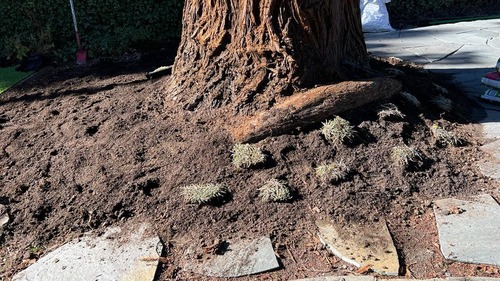
Extra Soil and Soft Landscaping Elements Can Remedy Surface Root Issues
Avoiding Harmful Practices
Most Important Rule: Do Not Cut Surface Roots If At All Possible!
Resist the temptation to cut surface roots except as a last resort, as cuts invite diseases and harmful insects. Cutting roots can negatively impact a tree's stability, making it more susceptible to falling during storms. Moreover, cutting roots kills thousands of tiny feeder roots that allow the tree to absorb water and nutrients, leading to dieback in the canopy or the death of the tree. If you really must, it is imperative that you consult a professional in doing so. Cutting the roots must be done selectively and only in the winter or early spring to give the tree the best possible chance of survival. Instead, focus on alternative strategies if possible.
Applying a Material Mix
Applying two inches of a mixture of equal parts topsoil and compost around the tree's base helps manage surface roots. Sow shade-tolerant grass seed in late summer, keeping the area well-watered. If the surface roots are still prominent within a year, repeat the process with an additional two inches of the mixture and reseed, but avoid suffocating the tree with excessive soil.
Mulching
Using mulch made of wood chips, apply a layer of four inches underneath the tree. This not only levels the area but also keeps roots cool and moist, allowing them to breathe. Be cautious not to exceed four inches of mulch or pile it against the trunk as this will suffocate the tree.
Smart Tree Selection
If the soil is compacted or clay-based, the tree will inevitably have some surface roots. That being said, some trees are far more likely to develop surface roots than others. These trees have inherently shallow root systems and are more likely to pose a problem in your landscape. Avoid planting well-known surface rooters, such as:
- Aspens: These fast-growing trees are notorious for developing extensive surface roots, making them a high-maintenance choice for landscaping.
- Beeches: While beech trees are valued for their beauty, they often come with the downside of aggressive surface roots that can disrupt the surrounding area.
- Norway Maples: Known for their vibrant foliage, Norway maples have shallow roots that tend to grow close to the surface, causing potential issues.
- Pin Oaks: Pin oaks are aesthetically pleasing but prone to surface rooting, making them a challenging option for areas where extensive root systems can be problematic.
- Red Maples: Despite their stunning red leaves in the fall, red maples can be problematic due to their shallow root systems, leading to surface roots.
- Silver Maples: Silver maples, while providing shade, are known for aggressive surface roots that may interfere with nearby structures.
- Willows: Willows are elegant trees, but their invasive root systems can cause issues, particularly in yards with limited space.
On the other hand, some trees have deeper root systems. These trees will make much better options in your landscape and are far less likely to develop surface roots. Some of the best options are:
- Black Gum
- Blue Atlas Cedar
- Ginkgo
- Golden Rain Tree
- Horse Chestnut
- Certain oak varieties (Red, Swamp White, White, and Willow)
- Planetree
- Yellowwood
- Zelkova
Consider Smaller Trees
Trees maturing at under thirty feet tall will usually not have roots large enough to cause major problems. Consider planting smaller varieties like cherry trees, dogwoods, magnolias, and Japanese maples to avoid major root-related problems.
Planting Depth Matters
Deeply planting a tree won't prevent surface roots. Plant trees two inches above grade, ensuring the root ball is not exposed to prevent it from drying out and incurring winter damage.
Providing Adequate Space
If your tree is near paved surfaces, ensure it has sufficient space to grow. Large-growing trees should be planted at least six feet away from these surfaces. If you want to plant your tree between a sidewalk and a street, make sure the planting spot is at least eight feet wide with no utility lines overhead. As some areas have restrictions and specific guidelines on planting, check with your local forestry department before planting.
Repairing Surface Root Damage
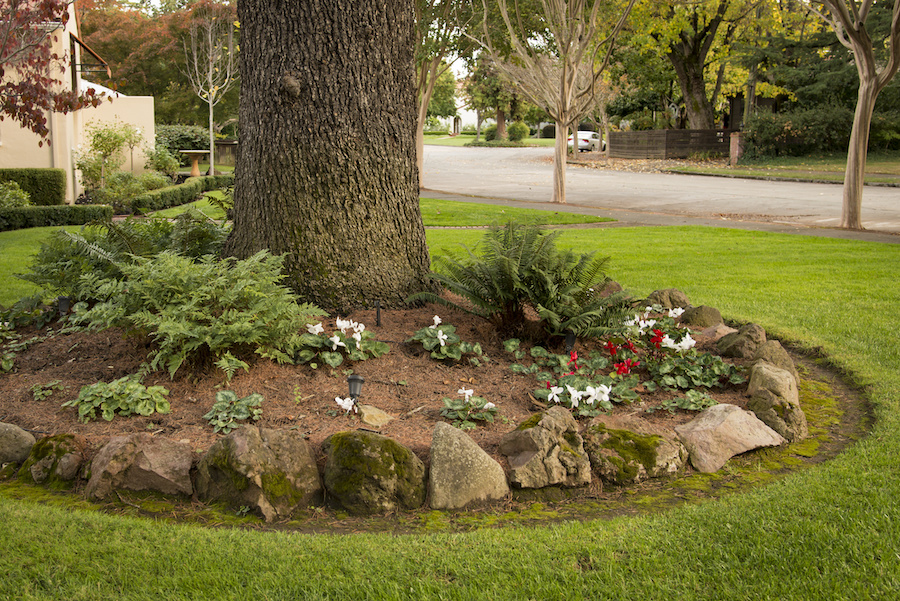
Mulch and Ground Cover Plants Help Prevent Surface Roots from Appearing
Assessing Surface Root Damage
Before initiating repairs, it's crucial to assess the extent of surface root damage. Identify raised sections, compromised structures, and potential issues with pipes. Once you have a clear understanding of the damage, you can implement targeted repair strategies.
Grinding Down Raised Sections
Raised sections caused by surface roots can be hazardous and unsightly. Stump grinders are effective tools for grinding down raised sections to create a smoother and safer surface. This process should be approached cautiously, and it's advisable to seek professional assistance to ensure precise and safe grinding.
Trenching and Cutting Problem Roots
Trenching involves creating channels in the soil to access and cut problematic surface roots. However, cutting roots should be done judiciously to avoid compromising the tree's stability. Consult with an arborist or tree care professional before trenching and cutting roots to ensure the tree's health is not adversely affected.
Pipe Relining or Replacement
Surface roots can infiltrate underground pipes, causing blockages and damage. For repairing damaged pipes, consider:
- Pipe Relining: This involves inserting a liner into the existing pipe, creating a new, durable inner layer. It's a minimally invasive method that avoids the need for extensive digging.
- Pipe Replacement: In cases of severe damage, replacing the damaged section of the pipe may be necessary. Use durable materials resistant to root intrusion.
Removing and Replacing Damaged Concrete
Concrete damage from surface roots can be a common issue. Here's how to address it:
- Removal of Damaged Concrete: Begin by removing the damaged concrete sections, ensuring a clean and smooth surface for replacement.
- Root Barrier Installation: Install root barriers along the affected areas to prevent future root intrusion. These barriers redirect roots away from structures.
- Concrete Replacement: Pour new concrete to replace the damaged sections. Use a mix that enhances durability and resilience against root pressure.
Mulching and Soft Landscaping
After repairs, implement preventative measures to minimize future surface root damage:
- Mulching: Apply a layer of mulch around the tree, extending to the root zone. Mulch helps regulate soil temperature, retain moisture, and discourage surface root growth.
- Soft Landscaping: Consider incorporating soft landscaping elements, such as ground covers and shrubs, to create a barrier between surface roots and structures. Ground covers will also eliminate the need to mow around the roots. Check out companies like Perfect Plants Nursery, who offer a wide variety of plants so you can find the perfect shrubs for your backyard.
Professional Assistance
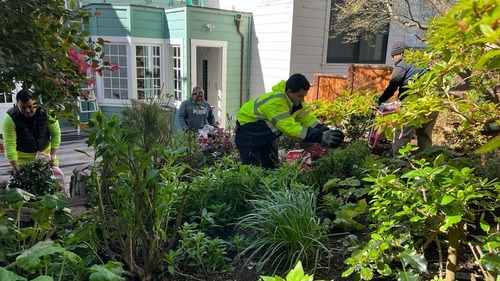
Workers Tend to a Lush Backyard Full of Greenery
There are a wide variety of methods available to manage surface tree roots. While some repairs can be undertaken independently, seeking professional assistance is advisable, especially for tasks involving roots and complex structural issues. Arborists and landscape professionals have the expertise to ensure repairs are conducted effectively without compromising tree health.
Conclusion
Repairing damage caused by surface roots requires a systematic and careful approach. By combining targeted repair strategies with preventative measures, you can maintain a safe, aesthetically pleasing landscape while preserving the health of your trees. Regular assessments and timely repairs contribute to the long-term well-being of both your trees and your property.
Managing surface roots is crucial for a safe and visually appealing yard. Shallow-rooted trees and poor soil quality can lead to various issues, including concrete damage, blocked pipes, tripping hazards, and challenges in lawn maintenance.
In the event of surface root damage, a thoughtful assessment is essential before implementing targeted repair strategies. This may involve grinding down raised sections, trenching, or opting for pipe relining. For more complex structural issues, seeking professional assistance from arborists and landscape professionals is advisable.
A comprehensive approach that combines prevention, assessment, and targeted solutions will ensure a safe and visually appealing outdoor space. Take proactive steps to manage surface roots and enlist expert help when needed for optimal results.
Originally posted on September 29, 2020





